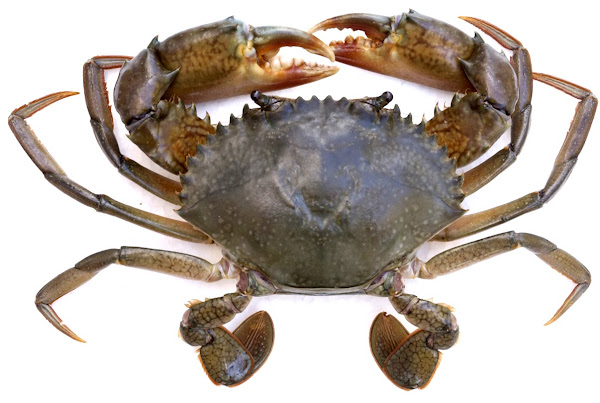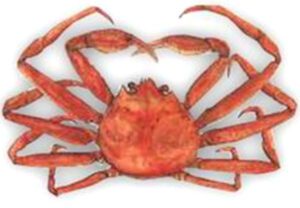Mud crab farming is a very profitable and popular business in many areas around the world. Growing mud crabs is very easy and give profits faster than many other agrifarming related business. Mud crab is very tasty and has huge demand and price in international market. Many countries throughout the world import huge amount of crabs for consumption every year. As a result, there are huge possibilities of earning foreign currencies by exporting crabs.
Commercial mud crab farming business is gaining popularity faster than ever. It’s very easy to start and highly profitable, and that’s the main reason of it’s high popularity. Mud crabs are mainly used for food. It is very popular as food throughout it’s range and also popular in the global market. That’s why starting commercial mud crab production is profitable.
What Is Mud Crab Farming?
Before describing more information about the steps about starting and operating a successful mud crab farming business, let us first explain more about what mud crab farming actually is. Mud crab farming is actually a practice of cultivating mud crabs in controlled environments (such as ponds, pens or even in cages). Mud crabs are raised from their juvenile stage for the purpose of using as food in local and international market.

Is Mud Crab Farming Profitable?
Yes, commercial mud crab farming can be a profitable business because there is high demand for crabs in both local and international markets. The crabs are sold for good prices in some countries such as China. However, starting this business in large scale requires some investment to set up the farm. Investment is required mainly to buy land, tanks, essential equipment, and to purchase feed for the crabs. Determine your marketing strategies before starting this business. Because, good profits from this business depends on good marketing facilities.
How To Start Mud Crab Farming Business?
Starting a commercial mud crab farming business is relatively easy and simple. But it can seem difficult for you if you are a beginner. So, we recommend having training or practical knowledge first before starting this business. Here we are trying to describe more information about starting and operating this business for generating more income.
Step 1: Gather Practical Knowledge First
Like many other farming business, having practical knowledge is very important in this business. So, try to gather practical crab farming knowledge first, before starting commercial production. You can learn practically about this business from any local farm or from any training center. You can contact your nearest fisheries institute to more about it.
Step 2: Make an Effective Business Plan
Try to make an effective mud crab farming business plan. A good business plan helps to run a business perfectly. You can ask for help from an expert for making your business plan. Try to include all aspects related to this business (from growing to marketing) in your business plan.

Step 3: Select a Good Location for Your Farm
Selecting a suitable location is a very important factor for starting and operating a successful mud crab farming. Here we are trying to list some important factors that affect mud crab production.
- Choose a site with access to clean and brackish water, as mud crabs thrive in these environments.
- Ensure that the location has a proper drainage system. Proper drainage system helps to prevent water logging and maintain optimal salinity levels.
- Availability of adequate amount sunlight is also essential for promoting the growth of algae and plankton, which serve as natural food for the crabs.
- Your selected area should have a sufficient supply of mangroves or other suitable habitats. Because, such habitats provide a sheltered environment for mud crabs to breed and molt.
- Conduct a soil test before selecting the area for your farm.
- Also ensure a market is available nearby for the ease of managing the farm and selling the harvested crabs.
Step 4: Purchase Required Equipment
Commercial crab farming requires various equipment. And availability of these equipment will help to operate a good and profitable business. Here’s a list of essential equipment:
- Crab ponds or tanks
- Water supply
- Aeration systems
- Crab hatcheries
- Crab nets
- Traps
- Crab sorting trays or tables
- Feeding equipment
- Water testing kits
- Temperature control devices
- Crab grading tools
- Disease prevention and treatment supplies
- Handling and processing equipment
- Record-keeping tools
- Transportation containers
Step 5: Select the Right Mud Crab Species
There are several types of mud crabs available for commercial production. Each of these types has it’s own unique characteristics and flavor. The most widely consumed and farmed species are the Giant Mud Crab or Mangrove Crab and Red Mud Crab, which are known for their sweet and delicate meat.

The Green Mud Crab and Black Fingered Mud Crabs are also popular mud crab species, while the Freshwater Mud Crab is a lesser-known freshwater mud crab. You can also consult with an expert or an existing farmer in your area for choosing the right species for your business.
Step 6: Select Right Mud Crab Farming Methods
Starting mud crab farming is very easy and simple, even the beginners can start this business. Mud crabs are raised in many different methods depending upon the available facilities in your area.
You can raise mud crabs in two systems. Grow out farming and fattening systems. Here we are trying to describe about these systems.
Grow Out System: In grow out farming system, young crabs are raised and grown for a certain period of 5 to 6 months till they reach marketing size and weight. This type of crab farming system is generally pond based. The pond size depends on the production type. Generally ponds for crab farming sized between 0.5 to 2 hectors. Proper bunds and tidal water exchange is a must. Small sized ponds are very suitable for crab farming.
Fattening System: Raising soft shelled crabs for a certain period until their exoskeleton gets hardened is known as mud crab fattening system. Growing crabs in this system take less time and the process is very profitable. You can start this business either in pond or also in cases.
Step 7: Maintain Optimum Water Quality
Water quality is a very important factor for successful mud crab farming business. Mud crabs require clean and well-oxygenated water for healthy growth and survival. Poor water quality can cause stress, disease, and death in mud crabs, leading to significant losses for farmers.
You should test the water regularly and make necessary adjustments to ensure optimal conditions for the crabs. By maintaining proper water quality, you can directly increase the chances of success and profitability.
Mud crabs prefer a pH range between 7.5 and 8.5. The ideal temperature range for mud crab farming is between 25°C and 30°C. They prefer water with salinity levels between 20 and 35 parts per thousand (ppt). The ideal dissolved oxygen level for mud crabs is between 5 and 8 mg/L.

Step 8: Feeding Mud Crabs
Feeding the mud crabs with good quality and nutritious food is the among the most important part of this business. For commercial production purpose, try to provide your crabs 5-8% food of their body weight. You can feed your crabs low cost trash fish, chicken waste, animal innards collected form slaughter house, brackish water clams etc.
Don’t served all the feed at once. Instead give it twice a day. Give major part of the total feeds during evening hours. Feeding mud crabs is an essential part of successful mud crab farming.
Mud crabs are omnivorous, which means they eat a variety of plant and animal-based foods. Providing a balanced and nutritious diet is crucial for their growth and survival.
Step 9: Breeding
The Mud crabs migrate offshore for spawning. They generally become mature when they reach around 9 cm carapace width. In most cases they become mature within their first year of life. The male crabs generally approach females, before the females have undergone a precopulatory molt.
Males start grasping them with their chelipeds and first pair of walking legs and carrying them around for up to several days until the females molt. Here are some tips for successful mud crab breeding:
- Ensure optimal environmental conditions for breeding, including appropriate water quality, temperature, and light cycles.
- Select healthy and genetically diverse broodstock.
- Provide a balanced and nutritious diet to promote reproductive health.
- Monitor the breeding process closely and make necessary adjustments as needed.
- Seek advice from experts or experienced breeders.
Step 10: Caring & Other Management
Mud crabs are very strong and hardy. They generally require less caring. Although, taking additional care will help the crabs to stay healthy and grow better. So, always try to take good care of your crabs. Monitor their health on a regular basis, and take necessary steps if you notice anything uncommon.
Step 11: Harvesting Crabs
You can start harvesting when the crabs reach minimum marketing size. Exact marketing size can vary from place to place, so ask your local traders. You can start harvesting the crabs by using traps, trawling, hooking, baited wire mesh pots and also by hand.

Step 12: Marketing Mud Crabs
After harvesting, wash the crabs with good brackish water and remove all types of dirt and mud. And then carefully tie the crabs without breaking their legs. Then try to keep those crabs in moist conditions. Keep them away from sunlight. Because direct sunlight has a negative effect on their survival. After that send them to the market.
These are the common steps for starting and operating a successful mud crab farming business. Hope this guide has helped you. Good luck and may God bless you!
Frequently asked questions (FAQs)
People often ask some questions regarding mud crab farming business. Here we are trying to listing the most common and frequently asked questions about mud crab farming and trying to answer them.
How to farm mud crabs?
Farming mud crabs is relatively easy and simple. You can farm mud crabs easily if you follow the steps mentioned above.
How to start mud crab farming?
First of all try to learn more about this business practically and gather knowledge. Make an effective business plan, select good location, and the purchase required equipment. Then select the right mud crab species and purchase crabs for stocking. Maintain optimum water quality, feed the mud crabs well, and take good care of them. And finally harvest the crabs and send them for marketing.
Are mud crabs farmed?
Yes, sure! Mud crabs are farmed in large scale in some countries, and it is a popular business.
How to start a mud crab farming business?
Starting a commercial and profitable mud crab farming business is relatively easy and simple. Just follow the steps mentioned above for starting and operating a successful farm.
What is mud crab farming?
Mud crab farming is the process of producing mud crabs in controlled environments like ponds or in cages. These process involves stocking crabs, feeding them, and taking good care of them. Commercial mud crab farming is very popular mainly due to the high market demand of crabs.







Hello. Can you tell me how to raise crabs?
No, I’m interested in raising crabs.
Contact WhatsApp +91 9345341451
thanks
Please share from where can we get the training for the same in India.
Where are you from? You can contact your local/nearest fisheries institute. Thanks!
I am interested with soft shell crab farming. Where i got tranning….?
Not sure exactly. But you can contact your nearest fisheries institute. Thank you!
Contact WhatsApp +91 9345341451
i am from maldives. can i get online training ? any where in the world. ?
I am Akpu, Michael Obinna, permission for the use of the article for further book makeup
Yes, you can definitely use it. But don’t forget to include the reference. Good luck!